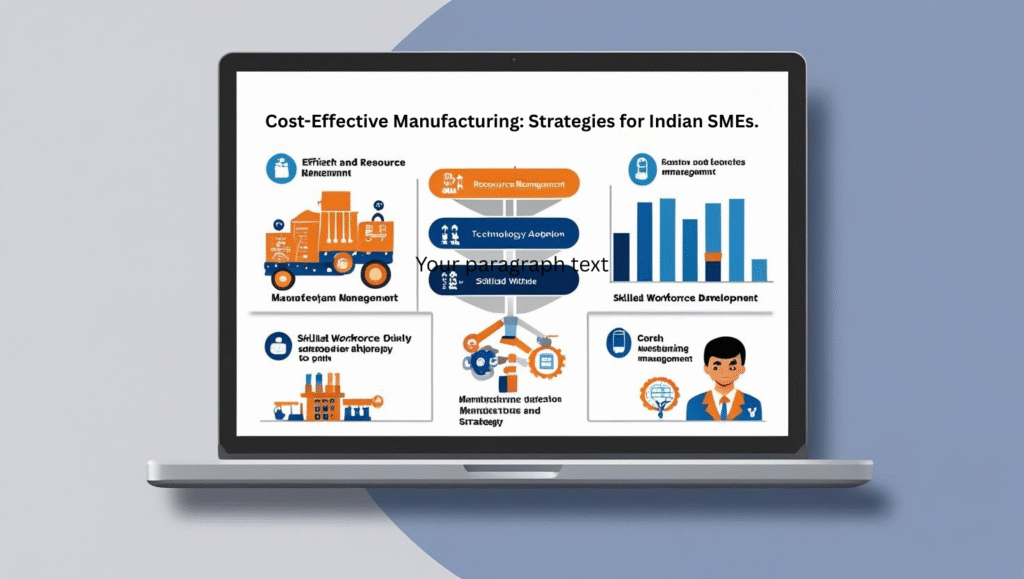
As India’s Small and Medium Enterprises (SMEs) face a rapidly globalizing economy, low-cost manufacturing has become a leading growth and viability driver.
Responsible for 45% of India’s manufacturing output and employing over 111 million workers, SMEs are facing rising input costs, intense competition, and limited resources.
With innovative strategies, government assistance, and embracing technology, these companies are learning to streamline operations and enhance profitability. Skill gaps and infrastructure shortages, however, may start to hold them back.
Value-cost production aims to reduce costs while not compromising on quality and efficiency. For SMEs with thin margins, this is critical in order to be competitive. Strategic cost management has the potential to reduce the production cost by 15-20%, allowing SMEs to expand operations and tap export markets, according to a 2024 Confederation of Indian Industry (CII) report.
Industries such as textiles, auto parts, and food processing are at the forefront, with Gujarat and Tamil Nadu-based SMEs achieving a 10% increase in profit margins through cost savings.
Lean manufacturing, which eliminates waste and simplifies processes, is one of the winning strategies. SMEs like those in Coimbatore’s textile clusters have adopted lean, cutting the cost of inventory by 25% through just-in-time (JIT) manufacturing, as per a 2023 study by the MSME Ministry. Automation is the other disruptor.
Low-cost robots and Internet of Things (IoT)-enabled machines, sourced from Indian companies like Addverb Technologies, have cut labor costs by 30% for SMEs in Maharashtra’s auto-component sector.
A tweet by @MSME_India quoted a Pune-based SME that saved Rs. 5 lakh annually by automating quality checks, increasing output by 15%.
Digital technologies are transforming cost control. Cloud-based solutions like Tally and Zoho enable SMEs to automate inventory and accounting functions at a cost advantage of up to 20% on administration costs.
The Open Network for Digital Commerce (ONDC) with 300,000 registered SMEs has lowered the cost of marketing by connecting firms directly with users.
Handicraft SMEs registered on the ONDC network in Rajasthan reported a 40% boost in online sales without relying on costly e-commerce platforms, as per a 2024 report.
Government schemes provide useful support. The Production-Linked Incentive (PLI) scheme, funded with $27 billion, promotes cost-effective manufacturing in sectors like electronics and pharma.
The Micro and Small Enterprises-Cluster Development Programme (MSE-CDP) supports common facilities like test laboratories, lowering capital costs of SMEs like those in clusters like Surat’s diamond industry.
The Credit Guarantee Fund Trust for Micro and Small Enterprises (CGTMSE) has enabled disbursement of Rs. 2 lakh crore of loans, making low-cost credit more accessible.
The Raising and Accelerating MSME Performance (RAMP) program, funded with Rs. 713 crore, promotes technology upgradation, affecting 50,000 SMEs since 2022.
Energy efficiency is another focus area.
As energy accounts for 20-30% of production expenses, SMEs are sourcing energy from the sun and energy-efficient machinery.
Tamil Nadu food processing units saved 15% on electricity bill by installing solar panels under the PM Suryaghar Free Electricity Scheme. Joint procurement in clusters also minimizes the cost of material.
Ludhiana auto-component SMEs, for instance, bundle raw material purchases together, saving 10-12% on bulk purchases, as per a 2023 CII study.
Despite all these developments, there are problems. High cost of automation, Rs. 5 lakh to Rs. 50 lakh for simple systems, scares most SMEs, just 10% of which have digital tools, a 2024 SIDBI report indicates.
Skills gaps are a stumbling block—only 5% of SME employees are Industry 4.0-skilled in AI and IoT, Nasscom observes. Infrastructural gaps, such as power unreliability in Tier 2 cities such as Kanpur, halt production, with an X post by @IndiaIndustry reporting frequent power cuts costing SMEs Rs. 1-2 lakh per month. Regulatory red tape, such as GST filings, weigh SMEs down with limited resources.
International competition exerts pressure. Nations like Vietnam in ASEAN enjoy lower import tariffs and labor costs, pitting Indian SMEs against foreign competitors. 30% of SMEs cannot implement global quality standards due to outdated machinery, as per a 2024 report by Deloitte.
International ESG pressures require the implementation of green technologies for climate change alignment, which is too expensive for most SMEs to implement without subsidies.
To bridge these challenges, specialists advocate targeted interventions.
Expanding subsidies on automation, such as in the Technology Upgradation Scheme, would reduce costs.
Increasing skill development through Skill India and partnerships with technology firms such as Microsoft would fill expertise gaps. Increasing power reliability of supply and last-mile connectivity, as envisioned under PM Gati Shakti, is the priority.
Industry captains such as Vineet Agarwal of CII advocate ease of compliance portals to reduce the cost of administration.
Low-cost manufacturing is propelling Indian SMEs to grow at a faster pace and compete globally. Encouraged by the government, digitalization, and innovative initiatives, these SMEs are driving India’s industrialization. Financial, skill, and infrastructure barriers must be overcome for inclusive growth, though.
Cost-effective SMEs will be the drivers towards a $2 trillion export goal by 2030—visionary intent exists, but only if the ecosystem allows their upgradation.
